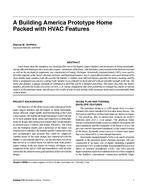With the added emphasis on energy conservation, no corrponent of a building has been thesubject of more controversy than the window. Windows are accused of being energy wastersby many people who take the short-sighted viewpoint that reducing the window areas in abuilding will reduce energy consumption. In evaluating the energy performance of a windowmany people simply consider the U-value of the product and compare it to the U-value of awell-insulated wall. With such a comparison it can be concluded that even a good insulateddouble glazed window product will conduct considerably more energy than a well insulatedwall. But a window is not a wall – it’s purpose is not to act as a wall does and be a totalbarrier to the outside environment, but rather to function as a natural value between theinternal and external environment. Windows are a source of illumination, ventilation, heating,cooling and provide the occupants of a building with needed interaction with the outsideenvironment. If these factors are not taken into account when designing a building, the quiteobvious solution would be the elimination of all windows in favor of highly insulated walls.However, numerous studies have proven that reducing windows in buildings does not necessarilyreduce the energy consumption of the building. Properly designed, located and managed windowscan actually reduce lighting, heating and air-conditioning costs. In essence, what needs tobe done is to consider windows as part of a total system rather than as an independent componentof the building. In analyzing windows in this manner and evaluating their totalcontribution to the energy performance of a building, it is possible to design a structurethat is not only energy efficient but also one that provides the architectural and humaninteraction characteristics traditionally accepted as desirable features of window usage.
The design of buildings to make proper use of windows and the management of windows tosave energy are extremely significant subjects that need to be addressed; they are specializedtopics in themselves and will not be discussed in this paper. The paper will deal specificallywith the very basic concept of window performance and the thermal testing of window products.
Citation: Symposium, ASHRAE Transactions, Volume 85, Part 1, Philadelphia, PA
Product Details
- Published:
- 1979
- Number of Pages:
- 21
- File Size:
- 1 file , 1.1 MB
- Product Code(s):
- D-PH-79-06-1


